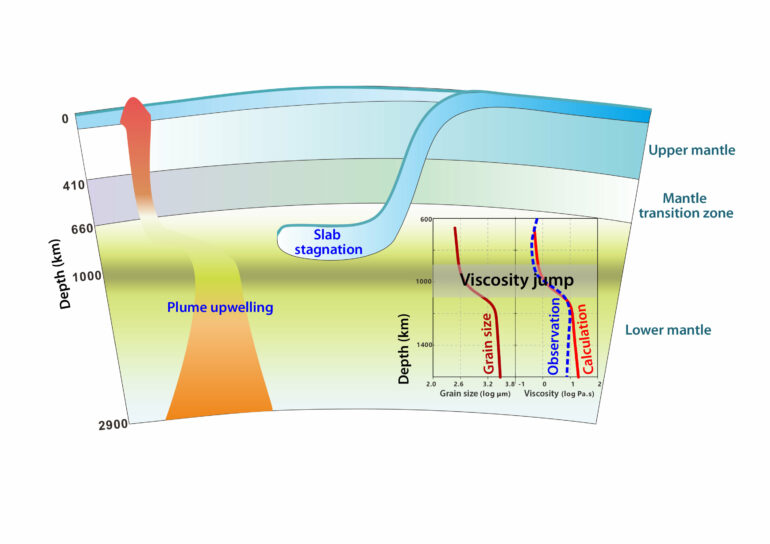An international research team led by Prof. Dr. Tomoo Katsura at the Bavarian Research Institute of Experimental Geochemistry and Geophysics, University of Bayreuth, has discovered why rocks in the Earth’s interior suddenly become more viscous at depths of 800 to 1,200 km. The cause of this change is the bridgmanite-enriched rocks that make up most of the Earth’s lower mantle below about 1,000 km. These rocks have a much larger grain size than the rocks above them, resulting in high viscosity. The new findings have been published in the journal Nature.
Bridgmanite is the most abundant mineral in the Earth’s lower mantle, which extends from a depth of 660 km to 2,900 km and occupies about half of the entire Earth. Scientists from Germany, China, France, the U.K., and the U.S. have discovered that the grain size of bridgmanite increases at around 1,000 km depth, as lower-mantle rocks are bridgmanite-enriched with increasing depth. As a result, there is a marked increase in viscosity in the shallower part of the lower mantle because viscosity has positive grain size dependence.
The shallower part of the lower mantle consists of pyrolite. This rock contains 20 vol% of other minerals in addition to bridgmanite. These additional minerals prevent the grain growth of bridgmanite. On the other hand, there are much smaller proportions of such minerals in the bridgmanite-enriched rocks, where bridgmanite can grow freely to large grains.
The resulting viscosity jump affects a wide range of geophysical and geochemical processes. “Although subducted plates sink rather smoothly into the lower mantle, their sinking is slowed down in the shallow part of the lower mantle. On the other hand, the upwelling of mantle plumes, which produce volcanoes in different areas of the Earth’s surface, seems to become rapid above 1,000 km depth. Although these observations were difficult to understand, we can now explain them rationally,” says the first author, Prof. Dr. Hongzhan Fei, who was a researcher at the Bavarian Research Institute of Experimental Geochemistry and Geophysics and is now a professor at one of the top universities in China, Zhejiang University in Hangzhou.
The highly viscous bridgmanite-enriched rocks were formed in the early history of the Earth. Because they are so viscous, mantle convection cannot mix them with other components of the mantle. As a result, the bridgmanite-enriched rocks have been preserved in the deep lower mantle for billions of years.
Prof. Dr. Tomoo Katsura, Chair of Structure and Dynamics of Earth Material at the BGI relates the new research results to seismic observations. “Seismologists have shown that many subducted slabs are stagnant in the layer between 600 and 1,500 km deep. They have also shown that, although plumes rise vertically and can be clearly imaged below a depth of 1,000 km, they become difficult to image above this depth. Our new theory can explain these observations. Because the viscosity increases with depth, the slabs have difficulties to penetrate into regions deeper than 1,000 km. On the other hand, the plumes rise faster at this depth, and so plumes become thinner and hard to image,” Katsura explains.
More information:
Hongzhan Fei et al, Variation in bridgmanite grain size accounts for the mid-mantle viscosity jump, Nature (2023). DOI: 10.1038/s41586-023-06215-0
Provided by
Bayreuth University
Citation:
Research team solves the riddle of the viscosity jump in the Earth’s lower mantle (2023, July 6)
